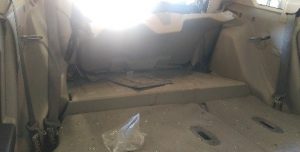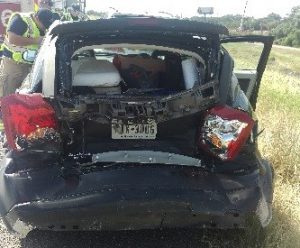Gravity, the force that attracts a body toward the center of the Earth, seems to be out to get me. I have been described as being “made out of fall down”. This is because I fall down. A lot. I have long legs and big feet and sometimes I don’t pick them up, so I trip. I ride my bike to work a lot and sometimes the potholes get me. Occasionally my adventures in science result in mystery bruises. Bruises and scrapes I can handle, but recently I had the opportunity to test some of Newton’s Laws in other ways.
I, in my little Dodge Caliber, was hit by a GMC pickup truck. After I took a hot minute to get my wits about me, I crawled out and looked at was left of the tail end of my car. My first thought? “Good job, crumple zones. Good job….” This is how we got to this blog entry. It’s been a while since High School Physics, so let’s all get caught up on some basics:
- Inertia is the tendency of an object to resist any change in its velocity (speed+direction).
- A fancier way to say that? Newton’s First Law of Motion states that a body at rest remains at rest unless acted upon by an external force and a body in motion continues to move at a constant speed in a straight line unless it is acted upon by an external force.
- Force = Mass x Acceleration (if Acceleration is the rate of change of the velocity)
In other words, unless some outside force acts on an object it will keep on going or staying, as the case may be. One of those outside forces is friction. Which brings us to inertia. A bigger, heavier object will take longer to get to a high rate of speed, but if the same force is applied, it will also take a longer time to slow down too. So a ping pong ball takes a lot less effort to stop than a freight train, but it also takes a lot less effort to throw a ping pong ball than it does a freight train. And so that brings us to the practical application portion of today’s blog.
Specifically, in the case of my accident, my little car had almost come to a stop when I was hit from behind. Since the truck was so much bigger, the truck had more momentum than my car brakes could handle—so I was pushed forward, even though the truck slowed significantly.

Even though there was a lot of damage done to the rear end of my car, I was still safe. This is because some physicists and engineers (thank you!) have been working to make vehicles safer. To do this, they have to take into account Newton’s Laws of Motion. Some of the safety features cars have these days are seat belts, crumple zones, air bags and specialized tires. Since you can’t instantaneously change the mass of the vehicles in an accident, your best bet is to change the acceleration to reduce the force. The function of the seat belts, crumple zones and air bags is to do just that by slowing things down more gradually. They change the acceleration of the person inside the vehicle by increasing the time it takes for the accident to occur – even if it is just by fractions of seconds.
Seatbelts comprise about 50% of your protection in a car. When a driver stops the car suddenly, the driver tends to lunge forward, because the driver’s body tends to maintain its speed and direction. The seat belt holds the driver and prevents the driver from flying forwards when the car stops. Seat belts help by applying a force that overcomes your inertia as in Newton’s First Law. They also increase the time in the wreck which results in a lesser impact force on you; more time means less acceleration to you! Even when your body comes to a stop, however, your internal organs continue to move, slamming against each other because of the impact. So, that’s fun.
Good tires are also an important safety feature on your car. The friction between the tires and the road determines the maximum acceleration and the minimum stopping distance. If the surface of a tire is rougher, then the friction force is larger. This is super important if you are slamming on your brakes to avoid something or speeding up, also to avoid something.
Prior to 1959, people believed the more rigid the structure, the safer the car. This ended up being deadly because the force from the impact went straight to the passenger. Crumple zones are specially engineered areas on your car that are designed to absorb energy as they are crushed and slow down the rest of the car more gradually. They absorb energy from a collision and therefore reduce the force of a collision on the passengers. They aren’t just spots that are softer or less dense on the car, they are specifically engineered to crush in a relatively gradual and predictable way that absorbs much of the impact energy, keeping it away from the occupants in what is termed a “controlled crush”.
So! Buckle up and be safe, and good job, crumple zones…good job.









